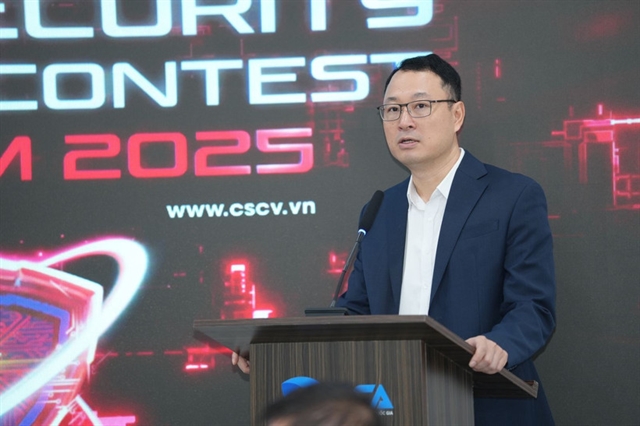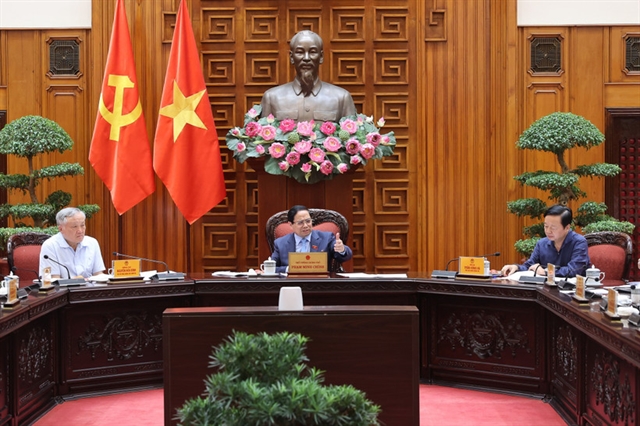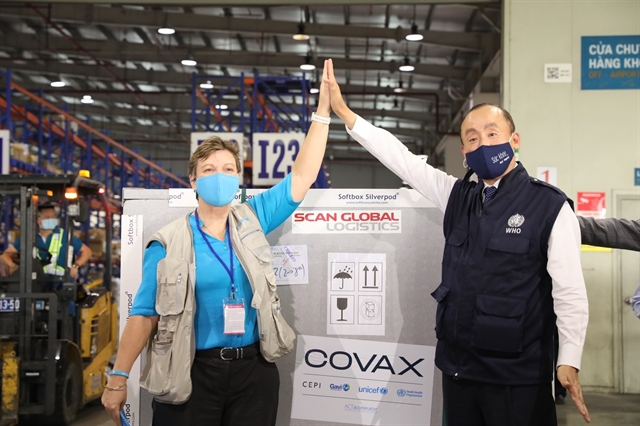 Opinion
Opinion

On the occasion of the delivery of the first batch of COVID-19 vaccine through the vaccine sharing scheme COVAX to Việt Nam, UNICEF Representative in Việt Nam grants an interview to Việt Nam News on the UN Children's Role in the efforts towards equitable vaccine access.

|
| UNICEF Representative to Việt Nam Rana Flowers and WHO Representative to Việt Nam Kidong Park in front of the COVAX shipment of COVID-19 vaccines to Việt Nam on April 1. — VNA/VNS Photo Minh Quyết |
On the occasion of the delivery of the first batch of COVID-19 vaccine through the vaccine sharing scheme COVAX to Việt Nam, UNICEF Representative in Việt Nam Rana Flowers speaks with Việt Nam News on UNICEF's efforts towards equitable vaccine access
Why is UNICEF involved in a vaccine for COVID-19 that is for adults?
If the world is to stem the spread of COVID-19 and urgently stop further mutations from occurring, effective vaccines must reach 80 per cent of the world’s population.
Beyond being an ambitious and essential goal that will allow economies to open and flourish – it is also an incredible moment in history, where the biggest and most complex vaccination campaign ever attempted is underway.
UNICEF for 75 years has been working to save children’s lives, to ensure they develop and thrive in life.
An important part of this work has been the procurement and delivery of vaccines to the world’s children – as well as to health workers.
UNICEF has built trust and as the biggest procurer of vaccines in the world has negotiated cheaper prices; it has also built a supply and logistics capacity that is unrivalled.
We have worked with ministries of health in countries to build capacity, to build the health system, to train and support the cold chain to every corner of a country, to ensure that every child is vaccinated and protected from life-threatening diseases.
Thus, for the COVID-19 vaccine rollout UNICEF is proud to be a key partner in the COVAC Facility; proud to have procured vaccines, to have airlines who will carry it free, and to be on the ground in Việt Nam to support the Ministry of Health in this enormous endeavour.
Việt Nam is receiving the first shipment of COVID-19 vaccines that UNICEF purchased on behalf of the COVAX Facility. UNICEF announced that the organisation plans to procure and deliver enough doses to immunise 20 per cent of the population in Việt Nam. Why 20 per cent?
Việt Nam has been very good in containing the spread of the virus but as one can see, COVID-19 cannot be beaten by one country at a time.
The epidemiology shows that no country will be safe from the fallout of the pandemic until all countries are protected.
Past pandemics saw a significant delay in access to life-saving medicines and other health products in low- and middle-income countries compared with wealthier countries.
Therefore, ensuring global equitable access to COVID-19 vaccines is very important.
The COVAX Facility is designed to provide all countries with an opportunity to participate in securing initial access to vaccine supply sufficient to cover at least 20 per cent of their population.
The WHO estimates that vaccines for 20 per cent of the population should be enough to immunise frontline healthcare workers, other essential workers, older adults, and those with significant comorbid conditions that increase the risk of serious COVID-19 illness in most countries.
This is to ensure all countries can immunise their highest priority, most at-risk groups and in so doing maximise the impact of the limited initial supply.
As a member country of the COVAX Facility, Việt Nam can access highly subsidised vaccine pricing at the same time as wealthier nations.
UNICEF has procured and will deliver enough doses of the COVID-19 vaccine to immunise 20 per cent of the population in Việt Nam. The first allocation of 4,176,000 doses of the AstraZeneca vaccine is expected to be delivered by the end of May 2021, and additional doses by the end of the year.
UNICEF will procure and supply doses of COVID-19 vaccines for the 92 low- and lower-middle-income countries on behalf of the COVAX Facility. We are working to ensure that all countries participating in the Facility (currently 190) have equitable access to 2 billion doses of the COVID-19 vaccine that we are purchasing by the end of 2021.
Once an allocation of 20 per cent for all countries participating in COVAX is met, additional allocations will be made to all participating countries using a weighted allocation framework that balances a country’s threat of infection and the vulnerability of its population and health system.
Or countries may opt to order additional vaccines through UNICEF. Countries are expected to share the cost of the additional allocations of vaccines.
Vaccines for low- and lower-middle-income countries will be financed through an advanced market commitment (AMC) funded from traditional sources of overseas development assistance.
Ninety-two lower- and lower-middle-income countries are eligible for vaccine financing through the AMC.
High- and upper-middle-income countries can self-finance vaccines through the facility.
Procurement and supply COVID-19 vaccines for the 92 countries is a challenging job. Why is UNICEF, an organisation working for children, involved in this?
Vaccinating the world against COVID-19 is undoubtedly the largest and fastest vaccine procurement and supply operation we have ever known.
UNICEF is leading this effort on behalf of the Global COVAX Facility based on our decades of experience in vaccine procurement. We are the world’s largest buyer of vaccines.
UNICEF has unique and longstanding expertise in procurement and logistics which ensures that children across the globe are immunised.
We procure more than 2 billion doses of vaccines annually for routine immunisation and outbreak response on behalf of nearly 100 countries.
We are the main procurement partner of Gavi, the Vaccine Alliance and have helped reach more than 760 million children with life-saving vaccines over the last 20 years, preventing more than 13 million deaths.
On behalf of the COVAX Facility, UNICEF has been negotiating with a number of manufacturers of COVID-19 vaccines to secure preferential pricing and enough doses for 20 per cent of the population of 190 countries participating in the COVAX Facility.
And this indeed is a challenging job, given the overwhelming demand, scarce manufacturing capacity and high-costs. In delivering the vaccines the challenges continue. Vaccines must be kept at specific temperatures.
Thus, UNICEF procures cold boxes, cold fridges, freezers and special refrigerator trucks which enable us to ensure that vaccines are kept at the right temperatures, from the moment they leave a factory to the point of inoculation.
This involves complex logistics with air freight carriers, refrigerated trucks, refrigerators and freezers, cold boxes and vaccine carriers, and temperature monitoring devices along the way, and at different levels of the cold chain system.
Are COVID-19 vaccines safe?
The WHO is responsible for vaccine quality – and is working to assess vaccines, to measure their efficacy and their safety. Each country has regulatory bodies that oversee vaccine safety and efficacy before they are used widely. Globally, the WHO co-ordinates a number of independent technical bodies that review the safety of vaccines prior to and even after they have been introduced. Vaccines that are approved for use by the WHO have gone through rigorous tests and clinical trials to show that they are safe and effective in controlling diseases. Even though COVID-19 vaccines are being developed as rapidly as possible, they can only receive the required regulatory approvals if they meet stringent safety and efficacy standards.
UNICEF, on behalf of the COVAX Facility, will only procure and supply COVID-19 vaccines that meet the WHO’s established safety and efficacy criteria. There have been some allergic and other problems identified, in fewer people than expected – and in all cases, every effort is made to ensure that any problems can be addressed immediately and the people return home safely.
In parallel, UNICEF is working to secure access to safe injection devices such as syringes, safe boxes and cold chain equipment such as refrigerators, and to support the MOH to ensure country readiness efforts for the roll-out of a COVID-19 vaccine. UNICEF, together with the WHO and other partners, is co-leading global efforts to ensure countries are ready to introduce and deploy the vaccine as soon as it becomes available. With the goal of reaching even those in the hardest to reach areas – the logistics, training of health workers and support to ensure the right medications are also available for any allergic reactions also need to be in place. Communication to and for the public is very important also, on the importance of vaccines, on what to expect when you are vaccinated, on the priority listing for who will get the vaccine and when is also crucial.
In Việt Nam, UNICEF has worked with the Government to assess cold chain capacity identifying where new fridges, trucks or cold boxes are needed. UNICEF has procured additional syringes and is procuring the additional cold chain to address the shortages or replace old equipment. Currently, UNICEF and the WHO are working with the MOH to roll out training for health workers and work with communities in addressing misinformation and building trust in vaccines and in the health systems that deliver lifesaving vaccines.
Should children get COVID-19 vaccines?
Very few of the initial vaccine trials included children. So, we do not have efficacy and safety data on children. There are tests underway where children are being given the vaccine and as soon as the scientific evidence is clear we anticipate adding additional doses of appropriate vaccines for children. Vaccines trials will continue to assess the impact of the vaccine.
Under the COVAX plan, the initial doses of vaccines sent to countries are intended for health workers, social care workers and people at high risk of severe illness from the virus, such as the elderly or those with underlying conditions. These populations have been prioritised to help reduce morbidity from COVID-19 and to help protect health systems that serve everyone. The guidance and availability are likely to be updated as we learn more, so it’s a good idea to check back on trusted sources like the WHO, as well as your local health ministry.
None of the currently available COVID-19 vaccines have been approved for children under the age of 18.
It is important, however, to make sure that your child continues to receive routine childhood vaccinations.
How can we protect children until they receive a COVID-19 vaccine?
The fact that we have a vaccine should not make us complacent.
We must all continue wearing masks, maintain physical distancing, and practice regular handwashing.
In Việt Nam, everyone should practice the “5K’s” as guided by the Ministry of Health. [Khẩu trang (face mask) – Khử khuẩn (disinfection) - Khoảng cách (distance) - Không tụ tập (no gathering) Khai báo y tế (health declaration)].
Vaccination will complement these measures which combined will help protect children, families and communities.
Equitable access and routine immunisation Regarding rich countries like the US and the UK having already administered millions of doses of COVID-19 vaccines while the developing world is still suffering from lack of access, Rana Flowers said the US has the severest outbreak in the world with more than 500,000 casualties. The US administration funded their vaccine companies to move ahead with the production of vaccines and their vaccines are those they are mostly using at this point, Flowers said. “All countries need to achieve 80 per cent of the population, and the fact that some countries can move ahead faster in the vaccination is welcomed since it allows the vaccine to be tested on different age groups and it ensures that we have a good sense now of any side effect to vaccination,” the UNICEF official said. The countries that are receiving the vaccines later are also benefiting from lessons regarding reactions, she said. “If it is just some countries getting the vaccines while others don’t, I would find that very unjust and inequitable, but the reality is, because of the COVAX Facility, every country is receiving some vaccines and every country should be able to ensure that at least their frontline and healthcare workers have received the vaccines,” she added. Routine immunisation The UNICEF official said during lockdowns, immunisation coverage has dropped as people have a fear of going to hospitals or health centres, so they have avoided regular vaccinations against other preventable diseases for children. “In 2020, part of the emergency response to COVID-19 was to ensure that there is outreach vaccination done and that every facility and health centre, after the lockdowns ended, carry out information campaigns to make sure that the parents book their children to catch up with the vaccination schedule. By the end of 2020, we were happy to see that the vaccination rate has returned to the rate that should have been at the end of the year,” Flowers said. She cited the example of major outbreaks of diphtheria witnessed in the Central Highlands of Việt Nam in July last year, saying this was a sign that there are some who still avoid vaccines. “This is problematic because as we know, places, where the vaccination is not achieved at the level of 80 per cent, will stand the risks of having major outbreaks,” she said. It’s a signal that we should do more to make sure people get their children inoculated against frequent diseases, Flowers said. — VNS |